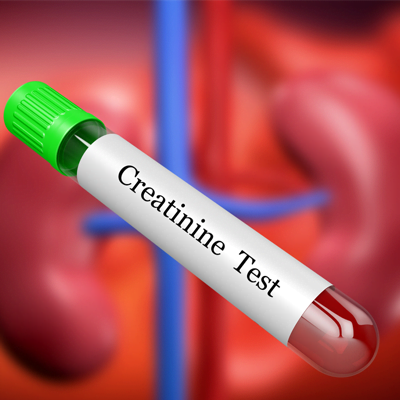What is creatinine?
During muscle metabolism, creatinine is a waste product produced in the muscles. It moves through the blood from the muscles to the kidney and is eliminated through urine. Healthy kidneys filter the blood to remove creatinine, and the body excretes creatinine as a waste product in urine. Therefore, Creatinine is a measure of how well the kidneys are eliminating waste from your blood
This form is currently undergoing maintenance. Please try again later.
Various symptoms of an increased creatinine are:-
- Diabetes
- Heart Disease
- Drug Toxicity
- Kidney Failure
- Kidney Infection
- Glomerulonephritis
- High Blood Pressure
- Urinary Tract Blockage
Causes of high creatinine levels
High creatinine levels can have a variety of causes, some of which may only occur occasionally. Dehydration, consuming a lot of protein, or taking the supplement creatine are a few examples. The kidneys may momentarily suffer from any of these and could result in severe issues like Kidney Failure, Kidney Infection, Kidney Stone, and Glomerulonephritis. However, other reasons for high creatinine levels could indicate a medical problem. Numerous of these disorders can harm kidney tissue or result in illness.
What harm does an increased creatinine do? And how to determine?
A creatinine test would be a good indicator of renal health. Little to no creatinine is reabsorbed in a healthy kidney, but the blood’s concentration of creatinine may rise with kidney failure. High creatinine levels may signify various health issues, such as chronic kidney disease (CKD). A serum creatinine blood test can determine how well the kidneys are working and whether there might be a problem, along with other factors, including age, weight, and medical history.
Why is reducing creatinine essential?
A disease or inefficient kidney function typically causes high creatinine levels. A symptom of kidney disease may also be abnormal creatinine levels. If creatinine levels are high, it is advised to address kidney failure’s cause or minimize creatinine generation with a healthy diet. A balanced diet may help; taking action is essential to lower the body’s creatinine level.
Patients with kidney disease can greatly benefit from yoga and breathing techniques. Yoga can improve immunological function, lower systolic and diastolic blood pressure, and lower urea and creatinine levels. In addition, yoga is a healthy treatment option for kidney disease sufferers. Additionally, it reduces body weight, serum cholesterol, blood pressure, and glucose levels.
How to reduce creatinine by yoga
The levels of creatinine can be reduced significantly with yoga and breathing techniques. The practice of Kapalbhati, Anulomvilom, and Pranayama enhances kidney function and treats renal issues. Daily morning and evening sessions of 15 to 30 minutes might be beneficial. Yoga has the potential to improve kidney function, control diabetes, and decrease blood pressure.
Running, jogging, and cycling are vigorous exercises that are not recommended for kidney patients. But pranayam and other yoga asanas have proven to be very effective. Regular yoga practice can help Chronic Kidney Disease patients’ quality of life (QOL) in addition to traditional treatment modalities by lowering creatinine levels, lowering blood pressure, improving kidney function, reducing the need for dialysis, and improving kidney function. There are numerous forms of yoga, including;
- Controlled breathing exercises (pranayama)
- Physical postures (asanas)
- Hand gestures (mudras)
Tadasana
In this, the hands and feet are placed at the sides of the body. Standing with the feet together, anchoring equally through the feet, and raising through the top of the head will help you get into the position. The spine is lengthened, the waist is elevated, and the thighs are lifted. Relaxed breathing is evident.
Urdhva Hastasana
Strengthen your arms and shoulders while lengthening from your side waist. Examine the opposing forces when you raise your arms over your head and ground via your feet. When you close your eyes, you can feel the power in your body and know that the ground is there to support you completely.
Utthanasana
Standing with feet pointed outward and legs apart. Hands should be gripped in front of the body. Take a deep breath. As you exhale, bend your knees over your toes. The upper body holds a straight posture. After taking a breath, stand straight up.
The asana is practiced in three stages. The hands should be at thigh level with the initial squat. Knee level with the second squat and calf level with the third squat. The trunk of the body should always stay upright while squatting.
Padahastasana
A variant of utthanasana, it’s a standing forward-bending pose where the toes are gripped. One can complete Padahastasana by bringing hands to the feet or by placing the hands underneath the feet with the palms facing upward.
The following sitting asanas may help too:-
- Paschimottanasana
- Ardhamatseyendrasana
- Purvottanasana
- Shashankasana
- Salamba Bhujangasana
- Setu Bandhasana(Bridge Pose)
- Naukasana
- Suptabaddhakonasana
The ability to do the asanas mentioned above becomes more flexible with time. Therefore, all these poses should be done slowly, with a break of two to three minutes between each position.
However, the yoga asanas mentioned above and meditational techniques may help reduce creatinine, and proper medical treatment is mandatory. Homeopathic treatment is the best advice here. Naturally processed medicines are the core of homeopathic treatment, with no side effects.


